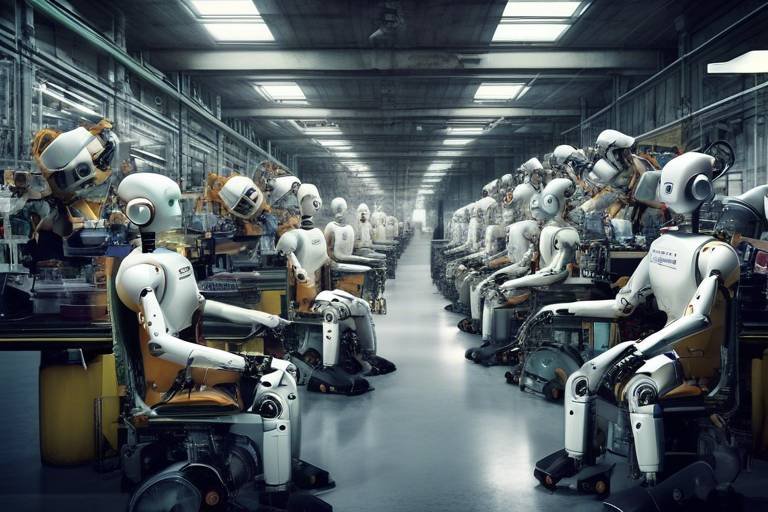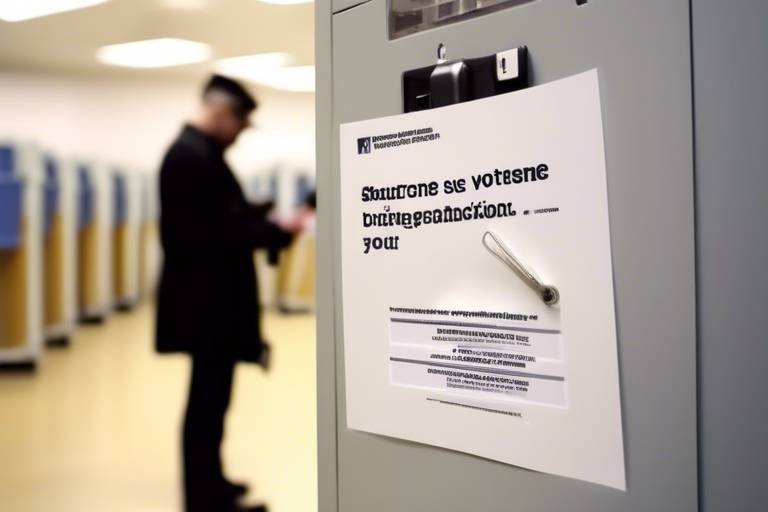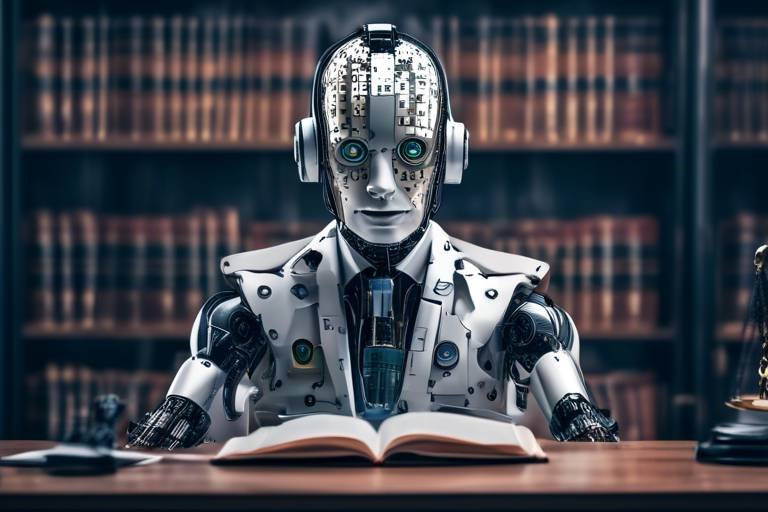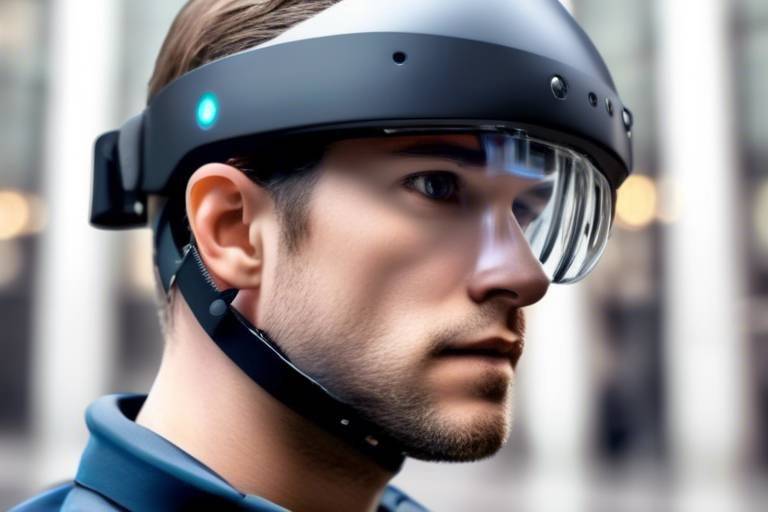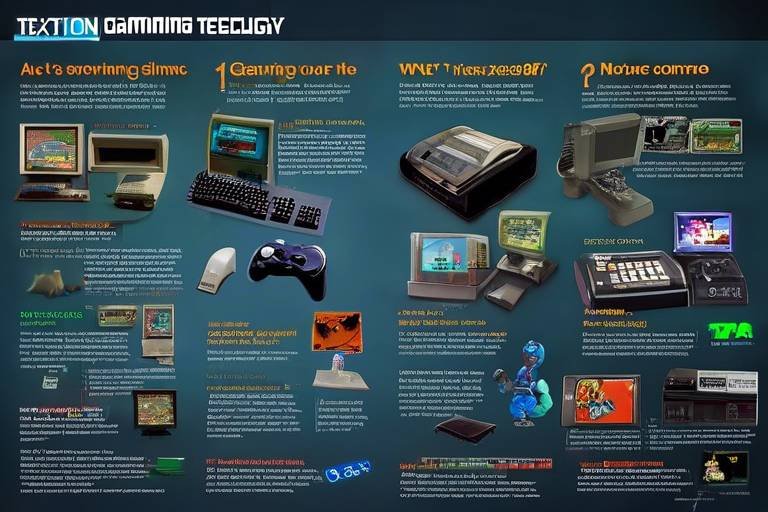Robotics in the Future - From Factories to Everyday Life
The dawn of a new era is upon us, where robotics is not just a figment of our imagination but a tangible part of our daily lives. Imagine waking up to a world where robots seamlessly integrate into our homes, workplaces, and even our healthcare systems. This transformation is not merely a futuristic dream; it is happening right now, with advancements in technology paving the way for a future that is both exciting and a tad bit daunting. From the assembly lines of factories to the comfort of our living rooms, robotics is set to redefine the way we live, work, and interact with the world around us.
As we delve into the various sectors where robotics is making an impact, it's essential to understand how this journey began. The evolution of robotics has been a remarkable one, starting from simple mechanical devices in the early 20th century to the sophisticated, intelligent systems we see today. This evolution has not only set the stage for future innovations but has also challenged our perception of what robots can do. Are they merely tools, or are they becoming partners in our daily tasks? The answer lies in the advancements we are witnessing today.
Robotics has come a long way since the days of early mechanical contraptions. The first robots were simplistic, often limited to repetitive tasks. However, as technology progressed, so did the capabilities of these machines. With the advent of artificial intelligence and machine learning, modern robots are now capable of learning from their environment, adapting to new situations, and even making decisions. This leap in technology has opened up a world of possibilities, allowing robots to perform complex tasks that were once thought to be exclusive to humans.
For instance, consider the evolution of robotic arms in manufacturing. Initially designed for basic assembly tasks, these robotic arms have now evolved into highly sophisticated machines capable of intricate movements and precise operations. This transformation is a testament to how far robotics has come and serves as a foundation for what lies ahead.
One of the most significant impacts of robotics can be seen in the manufacturing sector. The introduction of robots has revolutionized production processes, leading to increased efficiency, precision, and safety. Imagine a factory floor where machines work tirelessly alongside humans, performing tasks with a level of accuracy that surpasses human capabilities. This is the reality of modern manufacturing, where robotics plays a crucial role in streamlining operations and reducing labor costs.
Automation through robotics has transformed the way manufacturers operate. By minimizing human error and enhancing operational efficiency, companies can achieve higher productivity levels. For example, robots can work continuously without fatigue, completing tasks at a speed and accuracy that humans cannot match. This shift towards automation not only boosts output but also allows human workers to focus on more complex and creative tasks, ultimately leading to a more innovative workplace.
In this new age of manufacturing, collaborative robots, or cobots, have emerged as a game-changer. These robots are designed to work alongside humans, enhancing safety and productivity. Unlike traditional robots that operate in isolation, cobots are equipped with advanced sensors and AI, allowing them to interact safely with human workers. This collaboration fosters a new era of human-robot interaction, where both can learn from each other and improve overall efficiency on the factory floor.
However, the rise of robotics in manufacturing also brings with it concerns about employment. While some jobs may be displaced by automation, new roles are emerging that require advanced skills in robotics and technology. The key to navigating this shift lies in adapting to the changing job landscape. Workers will need to embrace lifelong learning and upskilling to thrive in a world increasingly dominated by robots.
The healthcare sector is another area where robotics is making significant strides. From surgical robots that assist surgeons in performing complex procedures to robotic-assisted rehabilitation devices that help patients recover, the integration of robotics in healthcare is enhancing patient outcomes and operational efficiency. Imagine a world where surgeries are performed with unparalleled precision, leading to quicker recovery times and fewer complications. This is not just a dream; it's becoming a reality thanks to advancements in robotic technology.
Beyond factories and hospitals, robotics is also infiltrating our daily lives. From smart home devices that automate mundane tasks to personal assistants that help us manage our schedules, robots are becoming an integral part of modern living. However, with this convenience comes challenges that we must navigate.
Smart home robotics, such as robotic vacuum cleaners and security systems, are designed to enhance comfort, security, and energy management in our homes. These devices can learn our preferences and routines, making our lives easier and more efficient. But as we embrace this technology, we must also consider the implications for privacy and security.
Looking ahead, the future of robotics in transportation is equally fascinating. Autonomous vehicles and drones are set to reshape urban mobility and logistics systems. Imagine a world where self-driving cars navigate our streets, reducing traffic congestion and accidents. This potential is exhilarating, but it also raises questions about safety, regulation, and the future of public transport.
- What are the main benefits of robotics in manufacturing? Robotics increases efficiency, precision, and safety while reducing labor costs.
- How do collaborative robots differ from traditional robots? Cobots are designed to work alongside humans, enhancing safety and productivity.
- What impact does robotics have on employment? While some jobs may be displaced, new roles requiring advanced skills in robotics are emerging.
- How is robotics improving healthcare? Robotics enhances surgical precision and assists in rehabilitation, leading to better patient outcomes.
- What are the challenges of smart home technologies? Concerns include privacy, security, and the implications of relying too heavily on technology.

The Evolution of Robotics
The journey of robotics is nothing short of fascinating, akin to watching a caterpillar transform into a butterfly. It all began in ancient times with simple mechanical devices designed to perform specific tasks. These early inventions laid the groundwork for what would eventually evolve into the sophisticated robots we see today. From the ancient Greeks' automata to the intricate machines of the Industrial Revolution, the path of robotics has been marked by innovation and creativity.
As we moved into the 20th century, the concept of robotics began to take a more structured form. The term "robot" was first coined by the Czech playwright Karel Čapek in his 1920 play, "R.U.R." (Rossum's Universal Robots). This marked a pivotal moment in history, as it sparked the imagination of inventors and engineers alike, leading to the development of more complex machines. The first industrial robot, Unimate, was introduced in the 1960s and revolutionized the manufacturing landscape by performing repetitive tasks with precision and speed.
Fast forward to the 21st century, and we find ourselves in an era where robotics has become an integral part of various sectors. Today, robots are equipped with artificial intelligence and machine learning capabilities, allowing them to learn from their environments and adapt to new challenges. This evolution has paved the way for robots to not only perform tasks but also to make decisions based on real-time data, enhancing their functionality and efficiency.
To better understand this evolution, let’s break it down into key milestones:
| Year | Milestone |
|---|---|
| 1920 | Term "robot" introduced by Karel Čapek. |
| 1961 | Unimate, the first industrial robot, is deployed. |
| 1980s | Robots begin to incorporate sensors and AI capabilities. |
| 2000s | Rise of collaborative robots (cobots) designed to work alongside humans. |
| 2020s | Advanced AI and machine learning lead to highly autonomous robots. |
This timeline illustrates just how far robotics has come, and it’s exciting to think about where it’s headed next. As technology continues to advance, we can expect to see even more innovative applications of robotics in our everyday lives. The integration of robotics into sectors like healthcare, manufacturing, and even our homes signifies a future where robots will play a crucial role in enhancing our quality of life.
In conclusion, the evolution of robotics is a testament to human ingenuity and our relentless pursuit of progress. As we stand on the brink of a new technological era, it’s essential to embrace these advancements and consider their implications for the future. Are we ready to welcome our robotic counterparts into our lives? The answer lies in our ability to adapt and innovate.

Robotics in Manufacturing
Robotics has dramatically transformed the landscape of manufacturing, ushering in an era where machines and human ingenuity work hand in hand. Gone are the days when factories were solely reliant on human labor for repetitive tasks. Today, robotics not only enhances productivity but also brings a level of precision and safety that was previously unimaginable. This evolution is not just a trend; it's a revolution that is reshaping how products are made and how businesses operate.
At the heart of this transformation is the concept of automation. By integrating robotics into manufacturing processes, companies are able to streamline workflows, reduce human error, and achieve unprecedented levels of efficiency. Imagine a factory floor where robotic arms assemble components with pinpoint accuracy, reducing waste and maximizing output. This is not science fiction; it is the reality of modern manufacturing. The benefits of robotics in manufacturing can be summarized as follows:
- Increased Efficiency: Robots can operate 24/7 without fatigue, significantly boosting production rates.
- Enhanced Precision: With advanced sensors and programming, robots minimize errors, ensuring higher quality products.
- Improved Safety: By taking over dangerous tasks, robots protect human workers from potential hazards.
- Cost Reduction: Although the initial investment can be high, the long-term savings in labor and material costs are substantial.
One of the most exciting developments in this field is the rise of collaborative robots, or cobots. Unlike traditional industrial robots that operate in isolation, cobots are designed to work alongside humans, enhancing productivity while maintaining a safe working environment. These robots are equipped with advanced sensors that allow them to detect human presence and adjust their operations accordingly. This collaboration fosters a new era of human-robot interaction on the factory floor, where workers can focus on more complex tasks while leaving repetitive, mundane work to their robotic counterparts.
However, the integration of robotics into manufacturing does raise important questions about the future of employment. While it is true that automation can lead to job displacement, it's essential to recognize that new roles will emerge as well. The demand for skilled workers who can program, maintain, and oversee robotic systems is on the rise. As industries evolve, so must the workforce. Upskilling and reskilling initiatives will be crucial in preparing workers for the jobs of tomorrow, which will likely require a blend of technical knowledge and human creativity.
As we look to the future, the implications of robotics in manufacturing are profound. The combination of automation, cobots, and a skilled workforce can lead to a manufacturing renaissance, where efficiency and innovation go hand in hand. Companies that embrace this change will not only thrive but also set the standard for the industry. The question is not whether robotics will play a role in manufacturing, but rather how quickly and effectively industries can adapt to this new reality.
| Question | Answer |
|---|---|
| What are collaborative robots? | Collaborative robots, or cobots, are designed to work alongside humans, enhancing safety and productivity in manufacturing environments. |
| How do robots improve safety in manufacturing? | Robots can take over dangerous tasks, reducing the risk of injury to human workers and creating a safer workplace. |
| Will robotics lead to job loss? | While some jobs may be displaced, new roles will emerge that require advanced skills in robotics and technology. |
| What are the long-term benefits of robotics in manufacturing? | Long-term benefits include increased efficiency, reduced labor costs, improved product quality, and enhanced workplace safety. |

Automation and Efficiency
In today's fast-paced world, the quest for efficiency has become a crucial driving force behind many industries, particularly in manufacturing. The introduction of automation through robotics has not only transformed traditional processes but has also paved the way for unprecedented levels of productivity. Imagine a factory where machines seamlessly communicate, adapt, and execute tasks with precision—this is the reality that automation brings to the table. By minimizing human error and optimizing workflows, robotics is revolutionizing how we approach production.
One of the most significant advantages of automation is its ability to streamline operations. With robots handling repetitive tasks, human workers can focus on more complex and creative aspects of their jobs. This shift not only enhances job satisfaction but also increases overall productivity. For example, consider a scenario where a robotic arm is responsible for assembling components on a production line. While the robot handles the consistent, high-speed assembly, human operators can engage in quality control or innovation, leading to a more dynamic and effective workplace.
Moreover, the integration of robotics into manufacturing environments leads to a significant reduction in operational costs. According to recent studies, companies that embrace automation have reported a remarkable decrease in labor costs and an increase in output quality. The following table illustrates the impact of automation on key performance indicators in manufacturing:
| Key Performance Indicator | Before Automation | After Automation |
|---|---|---|
| Production Rate | 100 units/hour | 250 units/hour |
| Labor Costs | $50,000/month | $30,000/month |
| Error Rate | 5% | 1% |
This table clearly demonstrates how automation can lead to substantial improvements in production efficiency. However, it’s important to note that while automation enhances efficiency, it also necessitates a shift in workforce skills. Companies must invest in training programs to equip employees with the necessary knowledge to work alongside advanced robotic systems. This evolution fosters a culture of continuous learning and adaptation, ensuring that the workforce remains relevant in an increasingly automated landscape.
In summary, the rise of automation through robotics is not merely a trend; it is a fundamental shift that is reshaping the manufacturing landscape. By enhancing operational efficiency, reducing costs, and allowing human workers to focus on higher-value tasks, automation is paving the way for a more productive and innovative future. As we continue to embrace these advancements, the question remains: how will we adapt to this new era of manufacturing? The answer lies in our ability to embrace change and invest in the future of work.
- What are the main benefits of automation in manufacturing? Automation improves efficiency, reduces labor costs, and minimizes human error.
- Will automation replace human jobs? While some jobs may be displaced, new roles will emerge that require advanced skills in robotics and technology.
- How can companies prepare their workforce for automation? Companies should invest in training programs to help employees adapt to new technologies and enhance their skill sets.

Collaborative Robots (Cobots)
In the rapidly evolving landscape of manufacturing and automation, collaborative robots, or cobots, are emerging as game-changers. Unlike traditional industrial robots that operate in isolation, cobots are designed to work alongside humans, enhancing productivity while ensuring safety. Imagine a factory floor where robots and humans seamlessly collaborate, each complementing the other's strengths. This synergy not only boosts efficiency but also fosters a more dynamic work environment.
The design of cobots prioritizes human-robot interaction. They are equipped with advanced sensors and AI capabilities that allow them to understand and respond to human movements and intentions. For instance, if a worker reaches for a tool, a cobot can adjust its actions accordingly, preventing accidents and ensuring smooth operations. This level of interaction is pivotal in industries where precision and safety are paramount.
One of the most exciting aspects of cobots is their versatility. They can be programmed for a variety of tasks, from assembly line work to quality control inspections. With user-friendly interfaces, even those without extensive technical backgrounds can easily set up and operate these robots. This accessibility opens doors for small to medium-sized enterprises that may have previously thought automation was out of reach.
Moreover, the integration of cobots into production lines can lead to significant cost savings. By taking over repetitive and physically demanding tasks, cobots free up human workers to focus on more complex and creative responsibilities. This not only enhances job satisfaction but also allows companies to allocate their human resources more effectively, ultimately leading to a more innovative workforce.
However, it's essential to address the concerns surrounding cobots and their impact on employment. While some fear that increased automation may lead to job displacement, the reality is more nuanced. Cobots are designed to augment human capabilities, not replace them. As companies adopt these technologies, new roles are emerging that require advanced skills in robotics, programming, and maintenance. This shift necessitates a focus on upskilling and reskilling the workforce to meet the demands of a more automated future.
In summary, collaborative robots represent a significant leap forward in the world of automation. They not only enhance productivity and safety on the factory floor but also pave the way for a new era of human-robot collaboration. As we look to the future, embracing this technology could be the key to unlocking unprecedented levels of efficiency and innovation in various industries.
- What are collaborative robots (cobots)?
Cobots are robots designed to work alongside humans in a shared workspace, enhancing productivity and safety. - How do cobots improve safety?
They are equipped with sensors that allow them to detect human presence and adjust their actions to prevent accidents. - Can anyone operate a cobot?
Yes, cobots are designed with user-friendly interfaces that make them accessible to individuals without extensive technical training. - Will cobots replace human jobs?
While cobots may take over repetitive tasks, they also create new roles that require advanced skills in robotics and technology.

Impact on Employment
The rise of robotics in manufacturing and other sectors is a double-edged sword when it comes to employment. On one hand, the integration of advanced robotic systems can lead to significant job displacement. Many traditional roles that once required human labor are being replaced by machines capable of performing tasks with greater efficiency and precision. For instance, assembly line jobs, which were once the backbone of manufacturing, are now increasingly handled by robots that can work tirelessly without the need for breaks.
However, it's essential to recognize that while some jobs may vanish, new opportunities are emerging in the wake of this technological revolution. The demand for skilled workers who can design, maintain, and operate robotic systems is on the rise. This shift necessitates a workforce that is not only technically savvy but also adaptable to new technologies. According to a recent study, it is projected that by 2030, the demand for jobs in robotics and automation could increase by as much as 20%.
Moreover, the introduction of robotics in the workplace can lead to the creation of entirely new roles that didn't exist before. For example, positions such as robotics technicians, AI specialists, and data analysts are becoming increasingly vital. These roles often require advanced skills and knowledge, which means that workers may need to pursue further education and training to stay relevant in the evolving job market.
It's also worth noting that the nature of work itself is changing. The traditional 9-to-5 job is being replaced by more flexible arrangements, where humans and robots collaborate closely. This collaborative environment not only enhances productivity but also allows human workers to focus on more creative and strategic tasks, leaving repetitive and mundane jobs to robots. For example, in a factory setting, while robots handle the heavy lifting and precision tasks, human workers can engage in quality control, troubleshooting, and innovation.
In summary, the impact of robotics on employment is profound and multifaceted. While there are challenges associated with job displacement, the potential for new job creation and the evolution of existing roles presents an exciting opportunity for the workforce. As we move forward, it is crucial for educational institutions, governments, and businesses to collaborate in providing training and resources to equip workers with the skills necessary for the jobs of the future.
- Will robots take away all jobs? While robots may displace certain jobs, they also create new opportunities and roles that require different skills.
- What types of jobs are most at risk? Jobs that involve repetitive tasks, such as assembly line work, are more susceptible to automation.
- How can workers prepare for the future job market? Workers can enhance their skills through training programs, online courses, and pursuing education in technology-related fields.
- Are there benefits to working alongside robots? Yes, collaboration with robots can lead to increased productivity, reduced physical strain, and the opportunity to engage in more creative tasks.

Robotics in Healthcare
In recent years, the integration of has been nothing short of revolutionary. Imagine a world where surgeries are performed with unparalleled precision, where recovery times are drastically shortened, and where patient care is enhanced through the use of intelligent machines. This is not science fiction; it's the reality we're stepping into. Robotics is transforming the medical field, making it more efficient and effective than ever before.
One of the most notable advancements is the use of surgical robots. These sophisticated machines allow surgeons to perform complex procedures with enhanced accuracy, minimizing the risk of complications. For instance, the da Vinci Surgical System has become a game-changer in minimally invasive surgeries. By utilizing tiny instruments and a camera, surgeons can operate through small incisions, leading to quicker recovery times and less pain for patients. This technology not only improves surgical outcomes but also reduces the overall burden on healthcare systems.
Beyond the operating room, robotics is making waves in rehabilitation. Robotic-assisted therapy devices are now being used to help patients regain mobility after injuries or surgeries. These machines provide consistent and precise movements that can be tailored to each patient's needs, offering a level of care that is difficult to achieve through traditional methods. For example, robotic exoskeletons are being utilized to assist patients with spinal cord injuries, enabling them to stand and walk again, significantly improving their quality of life.
Moreover, the role of robots extends to patient care. Robots are increasingly being deployed in hospitals and nursing homes to assist with routine tasks such as medication delivery, monitoring vital signs, and even providing companionship to patients. This not only frees up healthcare professionals to focus on more complex care needs but also enhances the patient experience. In a world where human interaction is crucial, robots can help alleviate feelings of loneliness among patients, especially the elderly.
However, with these advancements come challenges. The integration of robotics in healthcare raises important questions about ethics, job displacement, and the need for specialized training. As robots take on more responsibilities, healthcare professionals must adapt to new roles that involve working alongside these machines. This shift necessitates a focus on education and training to ensure that the workforce is equipped to handle the evolving landscape of healthcare.
To give you a clearer picture of the impact of robotics in healthcare, consider the following table that highlights some key applications:
| Application | Description | Benefits |
|---|---|---|
| Surgical Robots | Robots assisting in minimally invasive surgeries. | Increased precision, reduced recovery time. |
| Rehabilitation Robots | Devices aiding in physical therapy and mobility recovery. | Customized therapy, improved patient outcomes. |
| Service Robots | Robots performing routine tasks in hospitals. | Enhanced efficiency, reduced workload on staff. |
As we look to the future, the potential of robotics in healthcare is immense. The ongoing research and development in this field promise even more innovative solutions that can address complex medical challenges. So, the next time you hear about robots in hospitals, remember that they are not just machines; they are partners in healing, enhancing the way we approach health and wellness.
- What are the main benefits of robotics in healthcare? Robotics enhances precision in surgeries, improves rehabilitation outcomes, and streamlines routine tasks, ultimately leading to better patient care.
- Are robots replacing healthcare professionals? While robots assist in various tasks, they are designed to work alongside healthcare professionals, allowing them to focus on more complex care needs.
- How does robotic surgery differ from traditional surgery? Robotic surgery allows for smaller incisions, greater precision, and often results in quicker recovery times compared to traditional surgical methods.

Everyday Life Applications
The integration of robotics into our daily lives is not just a futuristic dream; it's a reality that is unfolding before our eyes. From the moment we wake up to the time we go to bed, robots are becoming an integral part of our routines, enhancing convenience and efficiency. Imagine waking up to a home that has already adjusted the temperature to your liking, brewed your coffee, and even prepared your breakfast—all thanks to smart home robotics. These devices are designed to make our lives easier, allowing us to focus on what truly matters while they handle the mundane tasks.
One of the most notable advancements in everyday robotics is the rise of smart home technologies. These include robotic vacuum cleaners that glide effortlessly across your floors, ensuring that dirt and dust are kept at bay without you lifting a finger. Additionally, smart security systems equipped with robotic features can monitor your home around the clock, providing peace of mind whether you're at home or away. The convenience these technologies offer is undeniable, but they also bring challenges, such as privacy concerns and the potential for technical malfunctions. Balancing the benefits and drawbacks is essential as we embrace these innovations.
Furthermore, robotics is making waves in the transportation sector, a domain that affects everyone. The advent of autonomous vehicles promises to revolutionize how we travel. Picture this: a self-driving car that knows the best routes, avoids traffic, and even parks itself. Not only does this technology aim to enhance safety by reducing human error, but it also has the potential to transform urban mobility. Drones, too, are set to change the game, with applications ranging from delivering packages to providing aerial surveillance. The possibilities are endless, and they raise intriguing questions about the future of commuting.
As we delve deeper into the world of robotics, it's essential to recognize the impact on our daily interactions. Personal assistant robots, for instance, are becoming more prevalent, helping us manage our schedules, remind us of important tasks, and even provide companionship. These robots are designed to learn from our habits and preferences, making them more effective over time. However, it’s crucial to consider how our reliance on these technologies may affect our social interactions and personal relationships.
To provide a clearer picture of how robotics is influencing our daily lives, here's a quick overview of some common applications:
| Application | Description |
|---|---|
| Smart Home Devices | Automated systems that enhance comfort and security in residential spaces. |
| Robotic Vacuum Cleaners | Devices that autonomously clean floors, saving time and effort. |
| Autonomous Vehicles | Self-driving cars that aim to improve safety and efficiency in transportation. |
| Drones | Unmanned aerial vehicles used for delivery, surveillance, and more. |
In conclusion, the applications of robotics in our everyday lives are vast and varied. They promise to enhance our comfort, safety, and efficiency, but they also challenge us to adapt to new forms of interaction and dependency. As we embrace these technologies, it’s essential to remain aware of the implications they bring to our lifestyle and society as a whole. Are we ready for a future where robots play an even more significant role in our daily lives?
- What are the benefits of using robotics in everyday life? Robotics can enhance convenience, improve efficiency, and provide safety in various daily tasks.
- Are there any risks associated with smart home devices? Yes, there are potential risks such as privacy concerns and technical malfunctions.
- How do autonomous vehicles improve transportation? They aim to reduce human error, optimize routes, and enhance safety on the roads.
- What is the future of robotics in daily life? The future may see even more integration of robotics, with advancements in AI leading to smarter, more efficient devices.

Smart Home Technologies
In today's fast-paced world, are becoming an integral part of our daily lives, transforming our homes into interconnected ecosystems. Imagine waking up in the morning and having your coffee brewed, the blinds opened, and your favorite playlist softly playing in the background—all without lifting a finger! This is the magic of smart home robotics, where convenience meets innovation.
At the heart of smart home technologies are devices that communicate with each other, often through a central hub or app. These devices range from smart speakers and thermostats to robotic vacuum cleaners and security systems. Each gadget not only enhances comfort and security but also promotes energy efficiency. For example, smart thermostats learn your heating and cooling preferences and adjust accordingly, potentially reducing your energy bills significantly.
One of the standout features of these technologies is their ability to be controlled remotely. With just a tap on your smartphone, you can adjust your home’s lighting, monitor security cameras, or even control appliances from anywhere in the world. This level of control not only offers peace of mind but also elevates the overall living experience. Let's dive deeper into some of the most popular smart home technologies:
- Smart Speakers: Devices like Amazon Echo and Google Home serve as personal assistants, allowing you to play music, set reminders, and control other smart devices with voice commands.
- Smart Lighting: Brands like Philips Hue offer customizable lighting that can be controlled via smartphone apps, enabling you to create the perfect ambiance for any occasion.
- Robotic Vacuum Cleaners: These handy devices, such as the Roomba, autonomously navigate your home, keeping your floors clean without you having to lift a finger.
- Smart Security Systems: With features like video surveillance, motion detection, and remote access, smart security systems offer enhanced safety for your home.
However, while the benefits of smart home technologies are undeniable, they also come with challenges. Privacy concerns are at the forefront, as many of these devices collect data about your habits and routines. It's essential to choose reputable brands and understand the privacy policies associated with these technologies. Furthermore, the integration of multiple devices can sometimes lead to compatibility issues, so it's crucial to ensure that your devices can work together seamlessly.
As we look to the future, the potential for smart home technologies is vast. With advancements in artificial intelligence and machine learning, we can expect even more intuitive devices that not only respond to our commands but anticipate our needs. Imagine a home that learns your preferences and adjusts itself accordingly—now that's a futuristic dream that’s rapidly becoming a reality!
In conclusion, smart home technologies are not just a passing trend; they represent a significant shift in how we interact with our living spaces. By embracing these innovations, we can enhance our quality of life, making our homes more comfortable, secure, and efficient. The journey into the world of smart homes is just beginning, and it's exciting to think about what the future holds!
Q: What are smart home technologies?
A: Smart home technologies refer to devices and systems that connect to the internet, allowing for remote management and automation of home functions, enhancing convenience, security, and energy efficiency.
Q: Are smart home devices secure?
A: While many reputable brands prioritize security, it's important to research and choose devices with strong security features and to regularly update their software to protect against vulnerabilities.
Q: Can I control smart home devices from my smartphone?
A: Yes! Most smart home devices can be controlled via dedicated smartphone apps, allowing you to manage your home from anywhere.
Q: Do I need a smart home hub?
A: A smart home hub can enhance compatibility between devices, but many devices can operate independently through their apps. It depends on your specific needs and the devices you choose.

Robots in Transportation
The landscape of transportation is undergoing a radical transformation, driven by the advent of robotics and automation technologies. Imagine a world where your car drives you to work while you sip your morning coffee, or where drones deliver your packages right to your doorstep. This isn't science fiction; it's rapidly becoming our reality. As we delve into the role of robots in transportation, it’s essential to understand both the exciting possibilities and the challenges that come with these innovations.
At the forefront of this revolution are autonomous vehicles. These self-driving cars use a combination of sensors, cameras, and artificial intelligence to navigate roads without human intervention. Companies like Tesla, Waymo, and Uber are investing heavily in this technology, aiming to create safer and more efficient transport systems. The implications are staggering: reduced traffic accidents, lower emissions, and a new level of convenience for commuters. However, the journey to fully autonomous vehicles is fraught with challenges, including regulatory hurdles, technological limitations, and public acceptance.
Another fascinating aspect of robotics in transportation is the use of drones. Drones are not just for aerial photography anymore; they are becoming key players in logistics and delivery services. For instance, companies like Amazon and Google are exploring drone delivery systems that could revolutionize how we receive goods. Picture this: you order a book online, and within minutes, a drone is hovering above your house, ready to drop it off. While this technology promises speed and efficiency, it also raises questions about safety, air traffic control, and privacy.
Moreover, robotics is also making waves in public transportation systems. Cities around the globe are experimenting with automated buses and trains. These vehicles can operate on fixed routes, reducing the need for human drivers and allowing for more consistent schedules. In some cities, pilot programs have already shown that autonomous public transport can lead to lower operational costs and increased ridership. However, integrating these systems into existing infrastructure poses significant challenges, including the need for advanced communication networks and public acceptance.
As we look to the future, the integration of robotics in transportation is not just about efficiency; it’s also about enhancing sustainability. With climate change at the forefront of global issues, autonomous electric vehicles and drone deliveries can significantly reduce our carbon footprint. Additionally, smart traffic management systems powered by AI can optimize traffic flow, minimizing congestion and emissions. This holistic approach to transportation could lead to cleaner, greener cities.
However, the rise of robotics in transportation also brings its own set of challenges. The potential for job displacement in driving professions is a significant concern. As autonomous vehicles become more prevalent, what happens to the millions of people who rely on driving for their livelihood? It’s a tough question, and society will need to find ways to adapt, potentially through reskilling programs and new job creation in tech-driven fields.
In conclusion, the integration of robots in transportation is reshaping our world, offering exciting possibilities while also presenting complex challenges. As we embrace these advancements, it is crucial to navigate the road ahead thoughtfully, ensuring that technology serves to enhance our lives rather than complicate them. The future of transportation is not just about the vehicles themselves but also about how we adapt as a society to these transformative changes.
- What are autonomous vehicles? Autonomous vehicles are self-driving cars that use sensors and AI to navigate without human input.
- How do drones impact delivery services? Drones can deliver packages quickly and efficiently, potentially revolutionizing logistics and reducing delivery times.
- What are the environmental benefits of robotic transportation? Robotic transportation can reduce emissions and improve traffic flow, contributing to more sustainable urban environments.
- Will robotics in transportation lead to job losses? Yes, there is potential for job displacement in driving professions, but new jobs may also be created in tech-related fields.
Frequently Asked Questions
- What are the main benefits of robotics in manufacturing?
Robotics in manufacturing significantly boosts efficiency, precision, and safety. By automating repetitive tasks, robots minimize human error and streamline workflows, leading to increased productivity and reduced labor costs.
- How do collaborative robots (cobots) differ from traditional robots?
Collaborative robots, or cobots, are designed to work alongside humans. Unlike traditional robots that operate independently in isolated environments, cobots enhance safety and productivity through direct interaction with human workers, creating a synergistic work environment.
- Will robotics lead to job loss?
While robotics may displace some jobs, they also create new opportunities that require advanced skills in technology and robotics. The landscape of employment is shifting, and workers will need to adapt by acquiring new skills to thrive in this evolving job market.
- How are robots being used in healthcare?
In healthcare, robots are revolutionizing patient care through surgical assistance, robotic rehabilitation, and even robotic companions. These innovations enhance surgical precision, improve recovery times, and provide support for healthcare professionals, leading to better patient outcomes.
- What are smart home technologies?
Smart home technologies encompass a range of robotic devices, such as robotic vacuum cleaners and automated security systems. These devices enhance comfort, security, and energy management in homes, making everyday living more convenient and efficient.
- What role do robots play in transportation?
Robots are set to transform transportation through autonomous vehicles and drones. These innovations promise to reshape urban mobility and logistics, potentially reducing traffic congestion and improving delivery efficiency.
- What are the future trends in robotics?
The future of robotics is bright, with trends such as increased integration of AI, enhanced human-robot collaboration, and advancements in mobility and autonomy. These developments will likely lead to even more innovative applications across various sectors.

